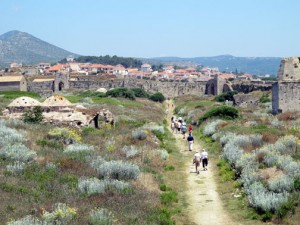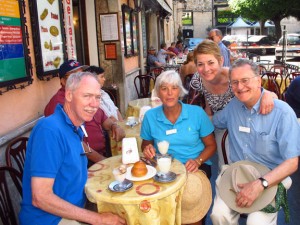A group of Lafayette College and Yale University alumni as well as members of Archaeological Institute of America and Smithsonian Institution traveled the Mediterranean earlier this summer aboard the Corinthian II.

Travelers walk along a path near the village of Methoni, Greece.
The ship set forth from Athens and sailed the realms that Homer used as a map of the Greek mind: from the ruins of Troy to the Palace of Nestor at Pylos, where Telemachus sought word of his father; Malta, the seductive isle of Calypso; Sicily of the Laestrygonians; the Phlegrean Fields of the cyclops; Taormina, home to the Oxen of the Sun; and finally, Ithaca, home to Odysseus and his wife Penelope.
“This trip was more than just sightseeing,” says Ed Blunt, of New Bern, N.C. “Voyagers easily interacted and got to know each other and the topic, even though many did not have a classical education background. The lecturers prepared the group for visits to historical and mythological sites and interacted with the travelers.”
On the “Journey of Odysseus: Retracing the Odyssey through the Ancient Mediterranean,” Diane Ahl, Rothkopf Professor of Art History, gave lectures on the lives of women in Greek art, on the legacy of Homer in European art, and on the male ideal in Greek art.
“The lectures by Diane Ahl were excellent,” says Blunt. “They were well thought out and presented in an extemporaneous fashion with vibrant style–no notes to read from–just excitement.”

Bill Kelleher '73 (L-R), his wife, Heidi Kelleher, Professor Diane Ahl, and her husband, Ken Ahl enjoy granite (ices) in Taormina.
William J. Kelleher ’73, a New Jersey municipal court judge and partner, Kelleher & Moore, Somerville, N.J., and his wife, Heidi, were among the passengers, who ranged in age from 12 to 90.
“This was an extraordinary trip,” says Kelleher. “The small size of the ship provided an intimate environment and it could enter harbors inaccessible to mega ships. The educational aspect was a bonus. Having a Lafayette professor on board and having that professor stand out among the group of lecturers was terrific. She was awesome. I highly recommend future trips of this type to all alumni.”
READ MORE about other upcoming Alumni Travel Program trips to China, Costa Rica, Holland, Alaska, Italy, and South Africa.
The 12 days began in Troy (Canakkale), where the Iliad ends and Odysseus’s journey home begins. The group visited major historical sites in Turkey, the Greek islands, Malta, and Sicily, including several UNESCO World Heritage Sites, associated with Odysseus.
“Led by expert guides and archaeologists, we saw palaces, ancient temples and theaters, caves, and fields in dramatic landscapes overlooking the Mediterranean,” says Ahl. “Onboard lecturers provided interpretations on the artistic, archaeological, and literary legacy of ancient Greece and led spirited discussions. Our fellow travelers included archaeologists, writers, teachers, attorneys, physicians, scientists, business people, musicians, and a young filmmaker. It was thrilling to share their passion for Homer and their love of learning.”
In addition to Ahl, lectures were given by C. Brian Rose, James B. Pritchard Professor of Archaeology and deputy director of the Museum of Archaeology and Anthropology, University of Pennsylvania; Elizabeth Bartman, president, Archaeological Institute of America; and Gordon Turnbull, general editor, Yale Boswell Editions, Yale University. Rose gave lectures about the excavations at Troy, Barman discussed the legacy of the Odyssey in Greek and Roman art, and Turnbull spoke about Homer and the Odyssey.
Kathy Junek, wife of a Yale alumnus, blogged during the journey. She wrote that she enjoyed a fascinating lecture by Ahl, on “Man Is the Measure of All Things: The Male Ideal in Greek Art.” “It is interesting to hear her comments on the young, male, idealized images. She has evidence, in the form of images on a pot, of men working naked in a bronze furnace area. There is some disagreement among the group about the wisdom of working naked among molten metal, but the evidence was on her side.”
Several travelers noted the visit to the village of Pylos at the southern tip of Greece, where they drove to the site of the Palace of Nestor, dating from the 13th century B.C.
“Pylos was particularly memorable,” Ahl says. “Archaeologists who have excavated there for over two decades led our tour of the surviving foundations. They showed us their newest, recently uncovered discovery—a painted, spiral frieze (band)—that adorned the walls. Homer came alive when one of our travelers read the description of the palace from the Odyssey. Another wiped tears from his eyes as he recounted his lifelong love of Homer. At the age of 60, he was finally realizing his dream.”

